This paper describes the design and development of GSM & GPS incorporated embedded system for simulated Blood pressure and Real Body Temperature Monitoring for aged people. The use of GSM is for communicating the abnormalities in the simulated biomedical parameters through SMS. The abnormalities in the set values will be immediately sensed by the system and buzzer will ring for help from the nearby people. In case no help is available within stipulated time, then the system sends short message to care taker‟s mobile phone. The GPS technology ensures in tracking such people by sending the longitudinal & latitudinal values in the message. The system is bi-directional, the status of parameters and location of the patient can be known by sending a SMS to the system or the system itself send SMS to concern people in case of abnormalities.
Keywords |
| Dual Band GSM modem, GPS receiver, Simulated Blood Pressure circuit, Microcontroller,
Temperature Sensor |
INTRODUCTION |
| Embedded systems are now a day widely used devices in a variety of applications such as home automation to
aerospace and medical diagnostic to agriculture etc. Incorporating acquired data from these devices in to wireless
application has very high acceptance. Hence wireless embedded systems are in use. Many of wireless technologies such
as short range wireless systems using 433 MHz ISO band for 300ft, very short range systems that uses Bluetooth
techniques, Zigbee wireless systems and GSM based systems are available. Such one GSM & GPS based application
for this wireless embedded systems for monitoring simulated blood pressure and real body temperature is attempted in
this paper for design and development. |
RELATED WORK |
| Rigidness” is the main drawback of any standalone dedicated embedded system, because it restricts the movement
of the person and requires always personal presence to control and monitor the processes or parameters [1-3]. Hence,
wireless embedded systems are more preferable in such applications. Short distance wireless embedded systems for
automated monitoring and controlling of various parameters are in use [4-6]. But there is a restriction of distance
between transmitting & remote unit. For biomedical applications it is advantageous to use wireless telemetry systems
as these biological signals can be well monitored on living subjects. „Bluetooth technology‟ a very short distance
communication method is also adopted by some researcher [7]. The GSM facilitates worldwide communication and
GPS which offers ability to locate an object anywhere on the earth. Some authors have pointed out the use of this GSM
& GPS techniques for monitoring and control of physiological parameters of patient from remote device [8, 10, 11]. It is the extension of my earlier work in which only GSM technology was implemented; now it is being studied along
with GPS facility [12]. The GSM/GPS communication methods can also be used even for automobile tracking [9]. |
| The proposed work deals the study of abnormalities in simulated physiological parameters and to intimate it to
caretaker using GSM network through SMS. The GPS receiver includes Longitudinal & Latitudinal values of the place
in the SMS, so that location awareness can be achieved. The system is compact, reliable and low cost. In this system,
monitoring and control of simulated physiological parameters is implemented for Blood Pressure, as the creation of
abnormalities on the living subject (human beings) is impossible. |
SYSTEM HARDWARE |
| This proposed paper explains GSM & GPS incorporated embedded system for simulated physiological parameter
monitoring & controlling system. The system comprises two units, one the system unit, the other is mobile unit or a cell
phone. It uses the GSM communication method which facilitates wireless communication between patient and
doctor/care taker through short message to the cell phone. The GPS technology is used for location awareness purpose.
as it sends Long & Lati values of a particular place. Because it is a bi-directional communication system, both system
unit & mobile unit (a cell phone) can acts as transmitter & receiver. The architecture of GSM & GPS is as shown in fig
1. The system unit, which is Atmel‟s 89C51 microcontroller based, collects the data from all sensors & compares for
any abnormalities from their set values. In situation of any deviations; it sends an SMS to the care taker‟s cell phone
along with new values of physiological parameters. |
| The system has ability to react to the SMS messages sent by family person/doctor, verifies the authenticity
(password) and then sends a reply message. By the response message sent by this system, the doctor or family person
can know the health status & location of the elderly person. Fig.2 shows the system block diagram. |
| The system hardware consists of the following features. The details of few hardware features are as follows; |
| 4.1 Embedded Microcontroller. |
| 4.2 Temperature sensor. |
| 4.3 Signal Conditioning Circuit. |
| 4.4 Blood Pressure Circuit. |
| 4.5 Analog to Digital Converter (ADC). |
| 4.6 Dual Band GSM Modem. |
| 4.7 Subscriber Identity Module. |
| 4.8 Short Message Service (SMS). |
| 4.9 GPS Receiver. |
| 4.10 Liquid Crystal Display. |
| 4.11 Emergency Micro-Switches. |
| 4.12 Power-supply. |
| 4.1 Microcontroller: It is the heart of this system. The controller used for this work is Atmel‟s 89C51 and it controls
overall activities by executing a program stored into its flash program memory. 89c51 is an 8-bit microcontroller with
internal flash program memory 8 kb, data memory 256 kb and 4-I/O ports. It is having a full duplex serial UART and
internal timer/counter. Hence, is a best choice for compact E.S design for such applications. |
| 4.2 Temperature sensor: LM35 temperature sensor is used for this work. It is a standard semiconductor transducer. It
has temperature range of -50°C to +150°C. It has to be fixed to the person‟s body and it produces 10mV/0C of body
temperature. This signal is suitably amplified and fed to the ADC. It is a real parameter. |
| 4.3 Signal Conditioning Amplifier: This amplifier is used to linearize the signal from LM35D temperature sensor. It is a
non inverting amplifier, and is suitable for D.C amplification. It gives high input impedance to the sensor, which avoids
loading of sensor circuit. The LM35D produces a voltage proportionate to °Centigrade. It produces 10mV/ °Centigrade.
The ADC 0809 has 20 mili volts resolution. That is, a count change in binary output of ADC 0809 requires 20 milli
volts of input. To get binary data equivalent of 35, an input of 700 milli volt is required. This voltage we can get by
amplifying the output of LM35D sensor by 20.This stage provides a gain of 20 to the input signal. The circuit diagram
is as shown in fig.3, IC LM324 (Quad Op-Amp) is main component of the signal-conditioning circuit. |
| 4.4 Blood Pressure Circuit: Creation of any abnormalities in the blood pressure on human subject is very difficult.
Hence, simulated blood pressure circuit is proposed in this system. Non Invasive Blood Pressure (NIBP) measurement
method is adopted by this system to measure the Systole and Diastole pressure values. Two potentiometers supply
analog signals, one representing Systole value and another representing Diastole value. Blood pressure (BP), also called
as arterial blood pressure, is the pressure exerted by circulating blood upon the walls of blood vessels, and is one of the
principal vital signs. "blood pressure" simply refers to the arterial pressure of the systemic circulation. It varies between
a maximum (systolic) and a minimum (diastolic) pressure during every heartbeat. It is measured in millimeters of
mercury (mmHg), for example 120/80. These analog signals are fed to two separate channels of the ADC. The ADC
converts these analog signals to 8-bit digital values and provides them to the microcontroller. The controller internally
compares them with their set point values to find out whether there are any abnormalities. |
| 4.5 Analog to digital converter (ADC): The ADC converts the analog signal into a binary number. When any analog
signal is applied at its inputs, it start the conversion process, an ADC converts the input signal into a proportional
binary value, by taking some time. When it finishes conversion and is ready with the digital data, it indicates with an
end of conversion signal. The controller can now read the data from ADC. It is a 8-bit, successive approximation type
ADC 0809. |
| 4.6 Dual band GSM modem: It is used to send and receive data through the GSM network. A Subscriber Identification
Module card and connectivity to the GSM is necessary. It has built in TCP/IP stack. It communicates with the
embedded system with AT commands. It works on two frequencies 900 MHz for up linking and 1800 MHz for downlinking,
hence, Dual band GSM MODEM. It is designed to work with RS232 standard, therefore, while connecting to
controller, a RS232 to TTL level converter is essential. |
| 4.7 Subscriber Identity Module: The key feature of GSM is the Subscriber Identity Module (SIM), usually called as a
SIM card. It is a removable smart card having user‟s subscription information and phonebook. |
| 4.8 Short Message Service (SMS): It is a cheap and convenient method of communicating in GSM technology. Since
the use of short message technique is a cheap, simple and flexible way of conveying data, many of wireless embedded
systems are now applying this technology in many different areas. One of such area is monitoring and controlling of
physiological parameters in telemedicine. |
| 4.9 GPS Receiver: Global Positioning System refers to a bunch of United State‟s. Defense satellites constantly
revolving the earth. GPS is a network of satellites that continuously transmit coded information, which makes it
possible to precisely identify locations on earth by measuring distance from the satellites. Generally, most GPS
receivers support the NMEA (National Marine Electronics Association) GPS Receivers are available as interface
modules from various manufacturers. Many GPS are able of sending information by a simple serial link. Only the TXD
and GROUND pins are to be connected. The GPS must be set at 9600 bps (or 4800), 8 bits, No Parity, and 1 stop bit.
The GPS Receiver proposed to be used in this system will receive all the coordinates needed from the GPS satellites. It
will send the information to the microcontroller. We will be using the GARMIN model GPS 12 XL. Because of its
compact size and low power operations, it can be incorporated into many portable devices such as the palm, laptop
computers, handheld radios, cell phones, automobile navigation systems and space navigation systems. As it is having
micro-sized board, the system integration can easily fit GPS functionality into portable products. It has the capability to
refresh its data once every second and therefore will be continuously updating the inputs for the microcontroller as the
object changes location. |
| 4.10 Liquid Crystal Display: It is a 16 pin module for display, having 2-line, 16 character with backlit facility is used.
The controller sends the signals to this module through its ports. |
| 4.11 Emergency Micro-switches: In case of any abnormalities, these emergency switches facilitate to ring the buzzer to
alert the people around and to get the help. |
| 4.12 Power supply unit: As this system is a wearable by the patient while in movement, hence it is essential that the
system has to work on batteries. It has rechargeable batteries, filter capacitors and voltage regulators. The batteries can
be charged by a normal charger. |
SOFTWARE IMPLEMENTATION |
| As this system is designed as a dedicated wireless embedded system, software is developed without the using any
generalized operating system. The program is written using assembly language because it produces compact hex code.
When power is applied the system turns ON from reset. The controller executes program and performs the following
tasks. |
| • Microcontroller Port configurations initialization. |
| • Serial Port Initialization, baud rate setting and enabling the Interrupt system. |
| • LCD display initialization and sets its parameters. |
| • Starts monitoring of physiological parameters |
| • Starts ADC and scans each Channel of ADC. |
| • Obtains BP values, Body temperature value from temperature sensor through ADC and displays on LCD
display. |
| • Comparison of present values with internal SET values. |
| • If abnormality occurs, displays a message on LCD and turns on the buzzer and waits for DISABLE button to
be pressed within predetermined time. |
| • If DISABLE button is pressed within predetermined time, it disables alarm and back to monitor parameters
again. |
| • Prepares SMS containing the values of physiological parameters. |
| • Sends SMS by communicating with GSM modem through AT commands. |
| • Disables alarm and goes back to monitor parameters again. |
| • GSM satellite identifies the GSM receiver by sending the LAT& LONG values |
| • Microcontroller receives the data and the same is sent as SMS. |
EXPERIMENTAL RESULTS AND DISCUSSION |
| The restricted movement of aged people because of their health conditions as mentioned above is tried to minimize
in the proposed system. The system is experimented its feasibility with GSM & GPS connectivity for simulated
physiological data monitoring and informing it to concern people in case of medical emergencies. It was attempted to
monitor the simulated physiological parameters of a person to be automatically from anywhere, without the restriction
of distance, location awareness and make use of GSM & GPS technology for communication and hence to extend the
range to unlimited. In case of emergency the person can ask himself for the help by pressing a micro-switch fixed to the
instrument whenever he is uncomfortable. If no help is sought in-time, the microcontroller obtains afresh data &
prepares a message and sends the information through GSM & with GPS receiver the location to the cell phone of the
doctor/care taker of the affected person. It will be a handy device for such people to get the critical help in time. And
hence serves as a life saving instrument for critically ill patients. |
| From the above discussions it is clear that the system is fully automatic, wireless, portable and gives the
communication of all the physiological parameters along with position of the person to the care taker‟s/doctor‟s cell
phone. |
| Details of the SMS sent by the GSM Modem are as follows: SYS=118 (Systole Pressure), DYS=013 (Diastole
Pressure) & BT=033 (Body Temperature) and Details of the location identification sent by the GPS receiver in the form
of longitude & latitude are as follows: LATITUDE=1718.8005.N & LONGITUDE=07652.6651.E, after putting these
values in the Google earth identified as our building. Even we have cross verified these LAT & LONG values with
Google map, identified as our research laboratory. |
CONCLUSION |
| The main objective of this work is to design & develop a low cost GSM & GPS incorporated simulated
physiological parameters monitoring system using Atmel‟s 89C51 microcontroller. The developed system is tested
successfully in the laboratory. The system makes use of many technologies such as sensors, data acquisition,
biomedical instrumentation, GSM & GPS. We have selected the suitable technology for the design. The system is
simple, low cost and potable. The purpose of the work was to reduce the hospitalization and medical cost and to
increase communication accessibility between patients and families. It is fact that, the populations of patients such as
elderly people will definitely gets benefited by the creation of such devices. |
| |
Figures at a glance |
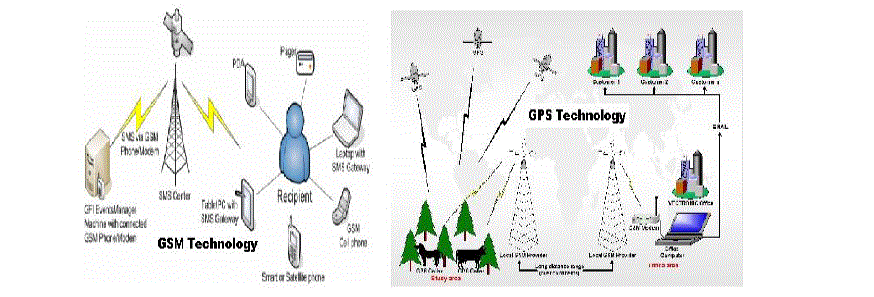 |
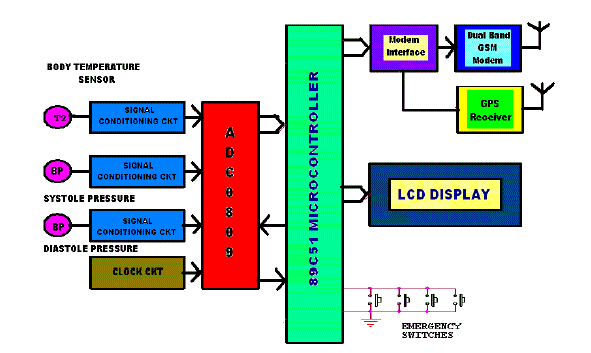 |
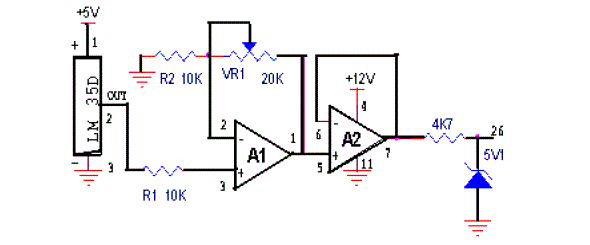 |
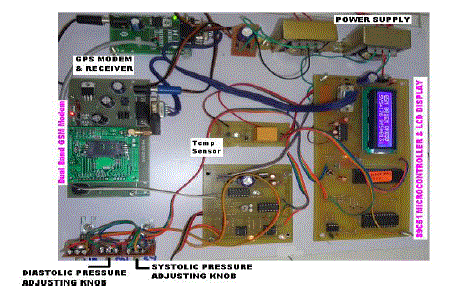 |
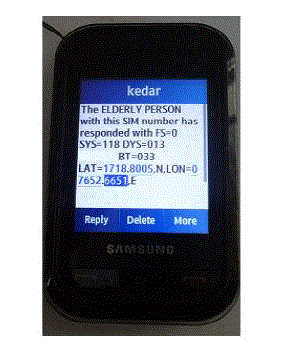 |
| Figure 1 |
Figure 2 |
Figure 3 |
Figure 4 |
Figure 5 |
|
| |
References |
- R.G. Jamkar and R.H. Chile “Microcontroller based Temperature Indicator and Controller”, Journal of Instrument. Society of India 34(3) pp.180-186, 2004.
- A.Rajendran and P. Neelamegam “Design of AT89C52 Microcontroller based system for the measurement of Temperature and control”, Journal of Instrument.Society of India 35(I) pp. 99-105, 2005.
- J. Jayapandian and Usha Rani Ravi “An Embedded Single Chip Temperature Controller Design” Journal of Instrument Society of India 38(2) pp.132-136, 2008.
- V.S. Waydande and A.N. Jadhav “Design & Development of Wearable Cardiac Telemonitoring System” Proceeding of International Conference on Communication, Computation, Control and Nanotechnology –ICN-2010, REC, pp. 211-213, 2010.
- B.Santhikiran., E. Vargil Vijay and M.V.H.Bhaskara Murthy “Design of Multi-Point Short Range Wireless Data Communication Systems” Proceeding of International Conference on Communication, Computation, Control and Nanotechnology –ICN-2010, REC, PP 266-270, 2010.
- Sudhindra.F., Vani.R.M.,Annarao.S.J. andP.V.Hungund “A Short Range Wireless Enbedded System for Measurement & Control of Temperature Using Atmel‟s 89C51 Microcontroller” Proceeding of International Conference on Communication, Computation Control and Nanotechnology –ICN-2010, REC, PP 457-460, 2010.
- Reza Fazel-Rezai., Mark Pauls and David Slawinski “A Low-Cost Biomedical Signal Transceiver based on a Bluetooth Wireless system” Proceedings of the 29th Annual International Conference of the IEEE EMBS Lyon, France, pp. 5711-5714, 2007.
- M.Harikrishna and Dr.K.PadmaRaju “GSM & GPS based System for monitoring of Elderly People” Proceeding of International Conference on Communication, Computation, Control and Nanotechnology –ICN-2010, pp. 94-99, 2010.
- IoanLita., Ion BogdanCioc., and Daniel AlexandruVisan “A New Approach of Automobile Localization System Using GPS and GSM/GPRS Transmission” Proceedings of IEEE, St. Marienthal, pp. 115-119 2006.
- XuMeihua., Fei Yu., Zhao Fangjie and Zhu Qian “A Remote Medical Monitoring System Based on GSM Network” IET International Communication Conference on Wireless Mobile and Computing (CCWMC-2009), pp.381-384, 2009.
- Aris Tanti Hapsari., Eniman Y Syamsudin and ImronPramana “Design of Vehicle Position tracking System using Short Message Services and its implementation on FPGA” IEEE, ASP-DAC 2005, pp.19-20, 2005.
- Sudhindra.F., Annarao.S.J.,Vani.R.M and P.V.Hunagund “A GSM Enabled Embedded System for Blood Pressure & Body TemperatureMonitoring” International Journal of Advanced Research in Electrical, Electronics and Instrumentation Engineering, Vol. 3, Issue 1, pp. 6957-6962 2014.
|